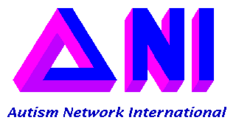Autism Network International
Autism Network International (ANI) is an advocacy organization run by and for autistic people. ANI's principles involve the anti-cure perspective, the perspective that there should not be a goal to "cure" people of autism.

| Autism rights movement |
|---|
 |
|
Events
|
|
Issues
|
History
ANI was started by Jim Sinclair, Kathy Grant and Donna Williams in 1992.[1] The advocacy group is organized by autistic people for autistic people.[2] ANI started out as a pen pal group, but when they first met in person, "they felt a sense of belonging, of being understood, of having the same concepts and sharing a language, of being normal."[3] Sinclair and the other founders created an online community where participants could discuss issues in the online forum.[4] ANI began publishing a newsletter, called "Our Voice," which was distributed through the ANI website.[5]
ANI is responsible for coining the word "neurologically typical."[6] Sinclair used ANI to help focus on the positive benefits of being Autistic, rather than the negatives.[4] ANI has helped autistic individuals learn "the important lesson of delighting in a shared autistic culture."[7]
Autreat
Autreat is a United States retreat and conference hosted by Autism Network International for autistic people. The first Autreat was in 1996,[1] and was held at Camp Bristol Hills in New York.[2] In 1999, there were 80 attendees, with one woman traveling from as far as Japan.[4] As of 2012, there has been an Autreat every year since then except 2001.
Autreat is a conference for autistic people "designed by autistic people.[8] It is a contrast to other autism conferences, which ANI believes are typically about autistic people but are intended for parents and professionals. Although parents, professionals, and others are welcome, Autreat is specifically designed for autistics, and offers an "autism friendly" environment, free of sensory bombardment. Common autistic mannerisms, like exceedingly literal conversation and hand-flapping, are to be expected. Common sources of autistic irritation, like casual hugs and fluorescent lighting, are not allowed.[9]
Guests are under no pressure to interact socially. A simple visual code in the form of a colored badge is used to indicate members who wish to interact with anyone and everyone, those who wish not to be approached by strangers, and those who wish not to be approached at all.[10] Autreat helps allow autistic individuals a "place to pursue and enjoy a nonconforming subculture."[11]
Autreat has inspired similar programs in other countries, such as Autscape in England and Projekt Empowerment in Sweden.[2]
See also
- List of disability rights organizations
References
- Shapiro, Joseph (26 June 2006). "Autism Movement Seeks Acceptance, Not Cures". NPR. Retrieved 29 February 2016.
- Silberman, Steve (23 September 2015). "Our Neurodiverse World". Slate. Retrieved 29 February 2016.
- Cohen, Shirley (2006). Targeting Autism: What We Know, Don't Know, and Can Do to Help Young Children With Autism Spectrum Disorders (3rd ed.). University of California Press. p. 204. ISBN 9780520933019.
- "Learning to Live With Autism". Syracuse Herald Journal. 16 August 1999. Retrieved 1 March 2016 – via Newspaper Archive.
- McConnaughey, Janet (21 October 1996). "Autistics Live In Chaotic World". Cedar Rapids Gazette. Archived from the original on 14 December 2019. Retrieved 1 March 2016 – via Newspaper Archive.
- Brownlow, Charlotte (1 July 2009). "Representations of Autism: Implications for Community Healthcare Practice". Community Practitioner. Archived from the original on 5 May 2016. Retrieved 29 February 2016 – via HighBeam Research.
- Paradiz, Valerie (2 February 2003). "This Is Who My Son Was Born To Be". Cedar Rapids Gazette. Retrieved 1 March 2016 – via Newspaper Archive.
- "'NeuroTribes' Examines The History — And Myths — Of The Autism Spectrum". Nashville Public Radio (NPR). 2 September 2015. Retrieved 29 February 2016.
- Harmon, Amy (2004-12-20). "How About Not 'Curing' Us, Some Autistics Are Pleading". The New York Times. Retrieved 2008-05-02.
- Sinclair, Jim. "History of ANI". Archived from the original on January 26, 2009. Retrieved 29 February 2016.
- Straus, Joseph (2015). "Autism and Serialism as Cultural Modernism". In Howe, Blake; Jensen-Moulton; Lerner, Neil; Straus, Joseph (eds.). The Oxford Handbook of Music and Disability Studies. Oxford University Press. p. 696. ISBN 9780199331444.
External links
- Official website
- Autreat official site for Autreat